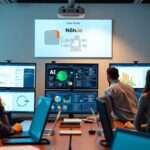NVIDIA is at the forefront of transforming neural network training with its DGX systems, optimized specifically for large language models (LLMs). By harnessing the power of cutting-edge GPUs and sophisticated software frameworks, you can significantly accelerate your machine learning workflows. These systems facilitate seamless scaling, allowing you to manage larger datasets while enhancing performance and resource efficiency. In this post, we will explore how NVIDIA’s innovations empower you to achieve greater results in LLM training, setting a new standard for speed and efficiency in artificial intelligence development.
Key Takeaways:
- Advanced Architecture: NVIDIA’s DGX systems feature a powerful architecture optimized for AI workloads, enabling faster training of large language models (LLMs).
- Scalability: The DGX systems provide exceptional scalability, allowing users to easily expand their computational resources to meet the growing demands of LLM training.
- Accelerated Computing: Leveraging NVIDIA’s GPUs, DGX systems deliver accelerated computing capabilities, significantly reducing the time required for LLM training processes.
- Software Ecosystem: NVIDIA integrates a comprehensive software ecosystem with its DGX systems, providing tools and libraries specifically designed for optimizing LLM development and training.
- Collaboration Opportunities: NVIDIA fosters collaboration across industries and academia, leveraging DGX systems to facilitate partnerships and advancements in LLM research and applications.

Understanding DGX Systems
For those looking to accelerate the training of Large Language Models (LLMs), understanding the capabilities and advantages of NVIDIA’s DGX Systems is vital. These systems are tailored specifically for artificial intelligence (AI) workloads, offering a high-performance platform that combines hardware and software to optimize deep learning tasks. By leveraging cutting-edge technology and immense computational power, DGX Systems provide the infrastructure needed to streamline your LLM training process.
Overview of DGX Architecture
On the architecture front, DGX Systems integrate **NVIDIA GPUs** with high-speed networking and storage, creating a unified and efficient environment for data processing. This multi-GPU setup enables parallel processing, which is crucial for handling the massive datasets typically associated with LLM training. The architecture is designed not only for speed but also for scalability, allowing you to expand your resources as your training needs grow.
On another level, DGX architecture emphasizes ease of deployment. With a fully integrated system, you can avoid the complexities of assembling disparate components. This holistic design ensures that the hardware communicates efficiently with each other, reducing overhead and maximizing throughput for your AI-driven applications.
Key Hardware Components
Any discussion on DGX Systems would be incomplete without an examination of the key hardware components that make these systems so powerful. At the heart of any DGX System are the highly specialized **NVIDIA A100 or H100 Tensor Core GPUs**, which provide immense computational capabilities tailored for AI workloads. These GPUs are engineered to deliver optimal performance while supporting mixed-precision computing, which is especially beneficial for training large models efficiently.
Any additional component that contributes significantly to the performance of DGX Systems is the **high-speed interconnects**. This includes technologies like NVLink and NVSwitch, which facilitate rapid data transfer between GPUs, enhancing communication and reducing bottlenecks. Such connectivity is crucial for effective multi-GPU training, allowing your systems to harness the full power of parallel processing.
The DGX System’s ability to enable efficient training can be attributed not just to its core GPUs, but also to its **robust cooling solutions** and **optimized power supply systems**. These components enhance system longevity and minimize thermal throttling, critical factors when running computationally intensive tasks over extended periods.
Software Ecosystem
One of the standout features of NVIDIA DGX Systems is their comprehensive software ecosystem designed for deep learning developers. Built on **NVIDIA’s CUDA** platform, the software stack supports popular frameworks like TensorFlow and PyTorch. This integration allows you to leverage the full power of your DGX System effectively while facilitating smooth transitions from research to production-ready models.
One major advantage of this software ecosystem is the availability of **NVIDIA NGC**, a registry containing pre-optimized software containers, models, and resources. This repository provides you with ready-to-use tools that come pre-configured for optimal performance on DGX systems, so you can focus on building and training your models rather than dealing with the complexities of environment setup.
Ecosystem compatibility is also a key focus; by leveraging NVIDIA’s software, you can ensure that your solutions are not only powerful but also compatible with various AI workflows. This integration streamlines your operations and opens up avenues for collaboration, allowing data scientists and engineers to work seamlessly across different platforms and projects.

The Importance of LLM Training
Little do many realize, large language models (LLMs) are at the forefront of transformative advancements in artificial intelligence. Their ability to understand and generate human-like text has opened doors to innovative applications across various sectors, from customer service chatbots to content creation and programming assistance. However, these models are not merely crafted from simple algorithms; instead, they require intensive training on extensive datasets to develop their remarkable capabilities.
What are Large Language Models?
What sets LLMs apart is their architecture, typically based on transformer models, which are designed to handle vast amounts of data efficiently. These models utilize mechanisms like attention to improve their understanding of context and relationships in the text. With billions, or even trillions, of parameters, LLMs can learn linguistic patterns and nuances, making them adept at tasks that involve generating or transforming textual content.
Moreover, LLMs are designed to continuously learn from new data inputs, which allows them to stay relevant and effective in dynamic environments. Consequently, the more comprehensive and diverse the training data, the better your LLM will perform, leading to enhanced outcomes in practical applications.
Challenges in Training LLMs
For anyone involved in training LLMs, it is crucial to recognize the substantial challenges that accompany this process. Training these models requires not just access to massive datasets but also substantial computational power, which often translates to high costs and increased complexity. Additionally, the performance of LLMs is heavily dependent on the quality of the dataset; any biases or inaccuracies can severely impact the model’s outputs.
Furthermore, the training process can be exceptionally time-consuming. Depending on the architecture and setup, it may take weeks or even months to reach optimal performance levels. This presents not only a logistical challenge but also cost implications for organizations; ensuring the training pipeline is both efficient and effective becomes paramount.
Importance of a structured approach to LLM training cannot be overstated. Your organization must implement robust processes to address issues related to data quality, computational efficiency, and ethical considerations. By adopting best practices, you can mitigate some of the challenges linked to LLM training and ensure that the final model outputs are both accurate and responsible.
Role of AI Frameworks
An crucial aspect of successfully training LLMs lies in employing the right AI frameworks. These frameworks provide the necessary building blocks for efficiently deploying deep learning models, allowing for faster experimentation and iteration. They often come with pre-built components that can simplify the arduous task of developing and training sophisticated models, enabling you to focus on enhancing model performance rather than getting bogged down by technical minutiae.
Moreover, leveraging robust AI frameworks can significantly facilitate collaboration among your team members. By standardizing tools and processes, everyone can work more cohesively, share insights, and drive towards common goals in LLM training, ultimately enhancing the overall productivity of your projects.
With the right AI frameworks at your disposal, you can streamline your workflow, dramatically reduce the time required for LLM training, and improve your ability to adapt to changing datasets. This advantage not only leads to better model outcomes but also firmly positions your organization at the forefront of AI innovation.
NVIDIA’s Approach to LLM Training
Unlike many traditional deep learning frameworks, NVIDIA has developed a comprehensive strategy that optimally harnesses its DGX systems for training large language models (LLMs). This approach focuses on delivering enhanced performance, reducing training time, and ensuring more efficient resource utilization. By leveraging their advanced architecture, NVIDIA offers capabilities that allow you to throughput massive datasets and run complex algorithms more effectively.
Optimizations in Data Processing
One key element of NVIDIA’s strategy involves significant optimizations in data processing. This includes utilizing high-throughput, low-latency data pipelines that are designed to handle enormous amounts of information. By fine-tuning these pipelines, you benefit from reduced bottlenecks during data ingestion, which speeds up the entire training process. NVIDIA’s solutions also enable you to maximize memory utilization, helping your models learn from the data more efficiently.
In addition to enhanced data pipelines, NVIDIA employs machine learning techniques that can intelligently preprocess data before it reaches the training systems. Techniques such as data augmentation and dynamic batching allow for a more varied dataset while maintaining rapid training speeds. As a result, you can focus on refining your models without being hindered by slow data processing capabilities.
Scalability of DGX Systems
Systems designed by NVIDIA are built with scalability in mind, allowing you to expand your computing resources seamlessly. This is particularly crucial for LLM training, where the demands for computational power can increase dramatically as your models grow in size. With DGX systems, you can add more GPUs as needed, optimizing both performance and efficiency, which ultimately translates into faster time-to-insight.
To further enhance scalability, NVIDIA’s DGX systems are equipped with NVLink technology, which enables high-speed communication between GPUs. This ensures that each GPU can work on different parts of the model concurrently, leading to a dramatic reduction in training times. The collaboration among GPUs not only boosts the overall throughput but also allows complex architectures to be managed without sacrificing performance.
Multi-GPU Configurations
Training LLMs effectively often requires deploying multi-GPU configurations, which NVIDIA optimizes through its DGX systems. With these configurations, you can distribute your model across multiple GPUs, greatly enhancing your system’s computational power. This level of parallel processing means you can handle larger datasets and more intricate models than would be possible with single-GPU setups.
Configurations in a multi-GPU environment also allow for better fault tolerance. By ensuring that the workload is balanced across several GPUs, if one component fails, the impact on your overall training process is minimized. This resilience is vital for long training cycles associated with large language models, as it protects your investment in both time and resources.
Performance Metrics
Despite the advancements in machine learning, the true measure of efficiency in training large language models (LLMs) comes down to performance metrics. Understanding how NVIDIA’s DGX systems stack up against traditional systems is important for researchers and businesses aiming to optimize their training processes. By harnessing superior hardware designed specifically for AI workloads, you can see significant improvements in model training times, throughput, and resource utilization.
Benchmarking DGX for LLM Training
Performance testing is crucial in evaluating how effectively you can train LLMs on DGX systems. By employing standardized benchmarks, NVIDIA showcases the capabilities of their DGX platforms, illustrating substantial gains in computational speed. The DGX A100, for example, considerably outperforms many conventional setups, making it an attractive choice for teams looking to accelerate their research and deployment timelines. You may find benchmarks indicating up to a 20x increase in training speed when compared to older generations of hardware.
Comparison with Traditional Systems
To highlight the stark differences between DGX systems and traditional computing frameworks, a comparative analysis reveals compelling evidence of DGX’s performance superiority. When you juxtapose the architecture and design specifics, you gain insights into enhanced speed, scalability, and performance efficiency. Below is a table illustrating some key metrics:
| Metric | DGX Systems |
| Training Speed (examples/sec) | Up to 20x faster |
| Throughput | Higher memory bandwidth |
| Scalability | Supports larger models/functions |
With traditional systems, you often encounter limited performance scalability, leading to longer training times and a bottleneck in resource allocation. This limitation can hinder your progress when working with expansive datasets and complicated model architectures. The following table illustrates a direct comparison:
| Aspect | Traditional Systems |
| Architecture | General-purpose CPUs |
| Optimum Workloads | Varied computational tasks |
| Cost of Training | Higher operational costs |
Energy Efficiency Considerations
Considerations surrounding energy efficiency are increasingly at the forefront of AI training methodologies. When you analyze the power consumption of NVIDIA DGX systems, the performance per watt becomes markedly impressive. The efficiency of these systems not only translates to cost savings but also aligns with your organization’s sustainability goals. Efficient energy usage reduces the overall carbon footprint associated with large-scale training of LLMs.
Furthermore, investing in NVIDIA’s advanced GPU architectures offers a dual benefit: achieving lower energy consumption while maximizing output. Wasteful energy practices can hinder your research objectives and result in unsustainable operating costs, thus focusing on power-efficient systems will provide long-term benefits.
Traditional systems often operate at considerably lower energy efficiency, making them less suitable for the rigorous demands of LLM training. Understanding these metrics allows you to make a more informed choice for your hardware investments, ensuring a more productive and environmentally friendly approach to AI development.
Use Cases of DGX Systems in LLM Training
Keep in mind that NVIDIA’s DGX systems are revolutionizing how organizations approach large language model (LLM) training. These powerful systems are designed to handle the immense computational demands of LLMs, allowing you to accelerate your research and application development. With the integration of DGX systems, you can streamline your workflows and achieve unprecedented performance in LLM training, paving the way for innovative solutions in various sectors. For more insight, explore AsiaPac’s NVIDIA Solutions: Large Language Models for Enterprises.
Research and Development
Systems equipped with NVIDIA DGX technology are at the forefront of advancing research and development in the field of LLMs. By leveraging the immense processing power and sophisticated infrastructure of DGX systems, researchers can train models that are larger and more complex than ever before. This capability not only accelerates experimentation but also enables rapid iteration cycles, thereby facilitating groundbreaking discoveries in natural language processing and artificial intelligence.
Additionally, with the inclusion of NVIDIA’s cutting-edge tools and software, the R&D process becomes even more efficient. You can harness a robust ecosystem that supports model optimization, making it simpler to test hypotheses and refine algorithms in a seamless manner. Consequently, your research can significantly benefit from the enhanced computational speeds and advanced capabilities of DGX systems.
Industry Applications
To effectively implement LLMs across various sectors, NVIDIA’s DGX systems serve as the backbone of many industry applications. These powerful systems enable organizations to harness the capabilities of LLMs for enhanced customer experiences, smarter business operations, and improved decision-making processes. Whether you are in finance, healthcare, or entertainment, DGX systems provide the crucial infrastructure that supports your organization’s unique needs when it comes to LLM training.
For instance, in the finance sector, DGX systems facilitate the training of LLMs to analyze market trends and automate customer service interactions. In healthcare, they support the development of models for drug discovery and patient diagnosis. By utilizing DGX systems, you can drive innovation and efficiency within your organization, leading to **positive** outcomes and a stronger competitive edge in your respective industry.
Collaborative Learning Platforms
Systems designed with NVIDIA DGX capabilities also play a pivotal role in fostering collaborative learning platforms. These systems not only accelerate individual training but also enable teams to work together on projects, sharing insights and leveraging collective knowledge. In this collaborative environment, you can engage in comprehensive discussions around model design and training strategies, leading to **more effective AI solutions**.
Another key advantage of DGX systems in collaborative learning is the capacity for real-time data sharing and model adjustments. This means that your team can swiftly adapt to new findings or setbacks, working cohesively to refine models and achieve optimal results. By enhancing collaboration among researchers and practitioners, DGX systems provide a fertile ground for innovation and shared learning, significantly advancing the state of LLM training.
Future Trends
Once again, NVIDIA is setting the pace for advancements in large language models (LLMs) with its DGX systems. The evolution of AI technologies has opened up new avenues for businesses to leverage LLMs efficiently, resulting in faster, highly scalable training processes. For those interested in embracing this frontier, start by exploring resources like Getting Started with Large Language Models for Enterprise Solutions. As you probe into these resources, you’ll discover that the future of AI is brightened with NVIDIA’s innovations in this space.
Innovations in DGX Technology
On the horizon, NVIDIA continues to innovate its DGX technology to make LLM training even more efficient and powerful. With advancements in GPU architecture and interconnect speeds, your data processing capabilities are reaching new heights. NVIDIA’s commitment to optimizing these systems means you can expect improved performance that allows for increased model size and complexity, giving you a distinct advantage in competitive applications.
Additionally, the introduction of unified memory and enhanced software frameworks for AI will enable you to utilize resources more effectively, reducing time and financial investments in your AI projects. These innovations reflect NVIDIA’s understanding of AI’s accelerating pace and ensure that you remain equipped with the best technology available as you explore future language models.
Evolving Needs for LLMs
One significant trend is the evolving needs for LLMs across various industries. Organizations are increasingly looking for models that not only deliver high-quality outputs but also demonstrate adaptability and real-time learning capabilities. As you integrate LLMs into your solutions, you’ll find the need for models that can understand context, support multiple languages, and provide safe and reliable outputs increasing rapidly.
Needs will likely continue to evolve as LLM applications broaden, encompassing customer service chatbots to sophisticated business intelligence tools. This opens the door for future innovations that you can capitalize on, particularly as organizations demand customizable solutions tailored to their unique workflows and objectives. The ability to seamlessly adapt LLMs to fit specific requirements will be paramount in setting your offerings apart in a competitive market.
The Role of Cloud Computing
On this journey towards effective LLM training, cloud computing plays a critical role in enhancing accessibility and scalability. With the ability to easily scale compute resources, you can manage larger datasets without the concern of physical constraints linked to on-premises infrastructure. Cloud platforms are evolving to provide flexible pricing structures, making it possible for organizations of any size to leverage powerful AI capabilities.
For instance, many cloud providers are now offering specialized AI services that integrate seamlessly with NVIDIA DGX systems. This synergy allows you to tap into cutting-edge technology while benefiting from the agility and scalability that the cloud provides. By harnessing the power of both, you can accelerate your LLM training without the substantial overhead traditionally associated with hardware investments.
Summing Up
Taking this into account, you can see how NVIDIA’s DGX systems play a pivotal role in enhancing the efficiency of large language model (LLM) training. By integrating cutting-edge hardware with optimized software and frameworks, NVIDIA provides an environment that allows you to harness the full potential of your neural networks. With features like high bandwidth memory, parallel processing capabilities, and robust ecosystem support, DGX systems ensure that you’re not only training models faster but also with greater accuracy and reduced costs. This combination is crucial for staying competitive in an AI-driven landscape.
Furthermore, as you explore the possibilities with NVIDIA’s solutions, you’ll appreciate the importance of tailored infrastructure for tackling complex AI challenges. DGX systems are designed to scale, meaning that as your projects grow in complexity, your capabilities can expand simultaneously. This flexibility allows you to adapt quickly to emerging trends and demands in the field of LLM development. Ultimately, by leveraging NVIDIA DGX systems, you position yourself at the forefront of innovation, enabling you to achieve remarkable results in your AI endeavors.
FAQ
Q: What are NVIDIA DGX Systems?
A: NVIDIA DGX Systems are high-performance computing servers specially designed for AI and deep learning workloads. They incorporate NVIDIA’s powerful GPUs, advanced software stack, and optimized tools to provide efficient training and inference for complex machine learning models, including large language models (LLMs). DGX Systems are equipped with a robust architecture that facilitates faster computation and data processing, enabling researchers and developers to push the boundaries of AI innovation.
Q: How does NVIDIA optimize LLM training with DGX Systems?
A: NVIDIA optimizes LLM training using DGX Systems by combining multiple GPUs for distributed training, allowing for parallel processing of data and model parameters. This parallelism significantly reduces training time for LLMs. Furthermore, NVIDIA’s software frameworks, such as TensorRT and NVIDIA NeMo, are integrated into DGX Systems, enabling streamlined model optimization and deployment. These tools support mixed-precision training, which enhances performance while maintaining model accuracy.
Q: What role does NVIDIA’s GPU architecture play in LLM training efficiency?
A: NVIDIA’s latest GPU architecture, such as the Ampere and Hopper architectures, is crucial for achieving high efficiency in LLM training. These architectures offer increased FP16 (half-precision floating-point) performance and dedicated tensor cores designed to accelerate matrix computations, which are fundamental for training deep learning models. This allows LLMs to train on large datasets faster and with lower power consumption compared to traditional computing systems.
Q: Can DGX Systems handle the training of very large language models?
A: Yes, DGX Systems are specifically designed to handle the training of very large language models (VLMs). Their architecture allows for the deployment of large compute clusters, facilitating the training of models with billions of parameters. With NVLink, a high-speed interconnect technology, DGX Systems enable fast communication between GPUs, ensuring that data transfer does not become a bottleneck. This capability is vital for training models that require extensive computational resources.
Q: What advantages do NVIDIA DGX Systems provide for research and development in AI?
A: NVIDIA DGX Systems offer several advantages for AI research and development, including reduced training times, scalability, and powerful compute capabilities. Researchers can leverage these systems to iterate quickly on model designs and conduct experiments on larger datasets. Additionally, DGX Systems come with a comprehensive software stack that includes pretrained models and a suite of development tools, making it easier for developers to implement cutting-edge technologies without starting from scratch.







